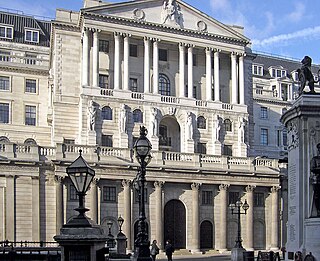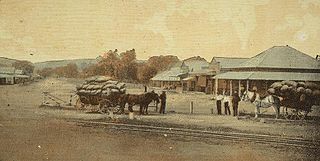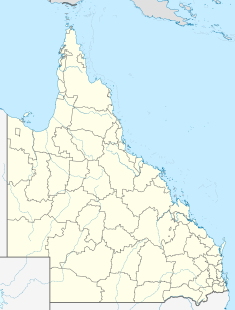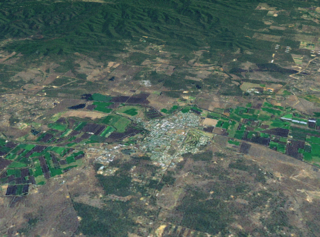
The Bank of New South Wales Building is a heritage-listed former bank building located at 33 Queen Street, Brisbane City, City of Brisbane, Queensland, Australia. It was designed by Hall & Devereux and built from 1928 to 1930 by F J Corbett & Sons. It is also known as Westpac Bank Building. It was added to the Queensland Heritage Register on 21 October 1992.

Family Services Building is a heritage-listed office building at 171 George Street, Brisbane City, City of Brisbane, Queensland, Australia. It was designed by George Gerald Hutton and built from 1914 to 1922. It is also known as former Administration Building, Queensland Government Insurance Building, and Queensland Government Savings Bank. It was added to the Queensland Heritage Register on 21 October 1992.

The Bank of New South Wales is a heritage-listed former bank at 242 Mary Street, Gympie, Gympie Region, Queensland, Australia. It was designed by Richard Gailey and built from 1890 to 1891 by T. Kelly. It is also known as Widgee Shire Council Chambers, Coolooa Shire Council Chambers and Gympie Regional Council Chambers. It was added to the Queensland Heritage Register on 15 April 2011.

Queensland National Bank is a heritage-listed former bank and former town hall at the corner of Channon Street and Nash Streets, Gympie, Gympie Region, Queensland, Australia. It was designed by John Richard Hall and Claude William Chambers and built from 1876 to 1877 by Andrew Collins. It was added to the Queensland Heritage Register on 15 April 2011.

Royal Bank of Queensland is a heritage-listed former bank at 199 Mary Street, Gympie, Gympie Region, Queensland, Australia. It was designed by Hugo Durietz and built in 1892. It was added to the Queensland Heritage Register on 15 April 2011.

Maryborough Heritage Centre is a heritage-listed former bank building at 164 Richmond Street, Maryborough, Fraser Coast Region, Queensland, Australia. It was designed by George Allen Mansfield and James Cowlishaw and built in 1877 for the Bank of New South Wales. It is also known as National Parks and Wildlife Service Headquarters, Post Master General's Department, and Telecom Building. It was added to the Queensland Heritage Register on 21 October 1992.

Commercial Bank of Sydney is a heritage-listed former bank building at 191–193 Bourbong Street, Bundaberg Central, Bundaberg, Bundaberg Region, Queensland, Australia. It was designed by George Allen Mansfield and built in 1891. It is also known as the National Australia Bank. It was added to the Queensland Heritage Register on 21 October 1992.

The National Australia Bank is a heritage-listed bank building at 61 Churchill Street, Childers, Bundaberg Region, Queensland, Australia. It was designed by Hubert George Octavius Thomas and built c. 1900. It is also known as Bank of Northern Queensland, Bank of Queensland, and National Bank of Australasia. It was added to the Queensland Heritage Register on 21 October 1992.

Queensland National Bank is a heritage-listed former bank building at 50 Churchill Street, Childers, Bundaberg Region, Queensland, Australia. It was designed by Philip Oliver Ellard Hawkes and built in 1919. It is also known as Childers Travel World, Wrench & Cobb, and Ye Olde Boutique. It was added to the Queensland Heritage Register on 21 October 1992.
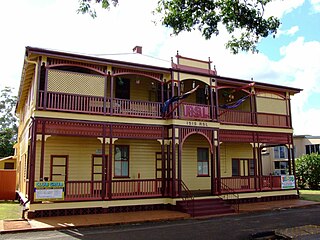
Childers RSL Club is a heritage-listed former bank and now Returned and Services League of Australia club house at 55 Churchill Street, Childers, Bundaberg Region, Queensland, Australia. It was designed by James Percy Owen Cowlishaw and built from 1900 to c. 1909. It was formerly a branch of the Commercial Banking Company of Sydney and is also known as the RSSAILA Club or the Isis RSL Club. It was added to the Queensland Heritage Register on 21 October 1992.
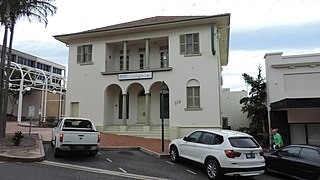
Commonwealth Bank Building is a heritage-listed former bank building at 114 Goondoon Street, Gladstone, Gladstone Region, Queensland, Australia. It was built from 1928 to 1929. It was added to the Queensland Heritage Register on 28 July 2000.
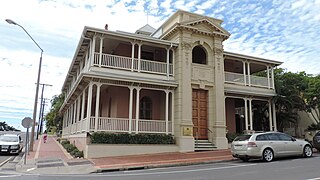
Kullaroo House is a heritage-listed former bank building at 40 Goondoon Street, Gladstone, Gladstone Region, Queensland, Australia. It was designed by James Percy Owen Cowlishaw and built from 1910 to 1911 by A A Carrick. It is also known as Commercial Banking Company of Sydney Ltd. It was added to the Queensland Heritage Register on 5 March 1999.

Bank of New South Wales Building is a former heritage-listed bank at 101-111 Flinders Street, Townsville CBD, City of Townsville, Queensland, Australia. It was built in 1887 by Denis Kelleher. It is also known as Australian Meat Industry Employees Union. It was added to the Queensland Heritage Register on 21 October 1992.

Westpac Bank Building is a heritage-listed bank building at 337–343 Flinders Street, Townsville CBD, City of Townsville, Queensland, Australia. It was designed by Hall and Cook and built in 1935 by Stuart Brothers (Sydney). It was added to the Queensland Heritage Register on 13 May 2004.
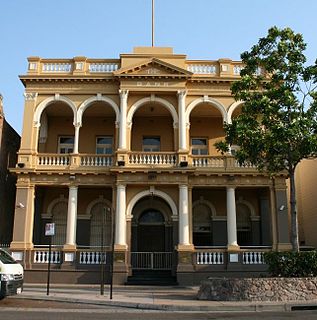
Australian Joint Stock Bank Building is a heritage-listed bank at 173 Flinders Street, Townsville CBD, City of Townsville, Queensland, Australia. It was designed by Francis Drummond Greville Stanley and built from 1887 to 1888 by MacMahon & Cliffe. It is also known as Australian Bank of Commerce and The Bank Nite Club. It was added to the Queensland Heritage Register on 21 October 1992.

Ferrari Estates Building is a heritage-listed former bank building at 126 Charlotte Street, Cooktown, Shire of Cook, Queensland, Australia. It was designed by Eyre & Munro and built from 1890 to 1891 by John Armstrong. It is also known as Bank of North Queensland. It was added to the Queensland Heritage Register on 21 October 1992.

Westpac Bank Building is a heritage-listed former bank building at 120 Charlotte Street, Cooktown, Shire of Cook, Queensland, Australia. It was designed by Francis Drummond Greville Stanley and built from 1891 to 1891. It is also known as Bank of New South Wales and Queensland National Bank. It was added to the Queensland Heritage Register on 11 March 1994.
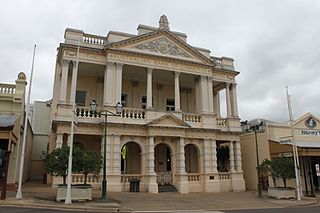
Australian Bank of Commerce is a heritage-listed former bank building at 86 Mosman Street, Charters Towers, Charters Towers Region, Queensland, Australia. It was designed by Francis Drummond Greville Stanley and built in 1891 by Wyatt & Gates. It is also known as The Australian Joint Stock Bank and is now The World Theatre. It was added to the Queensland Heritage Register on 21 October 1992.
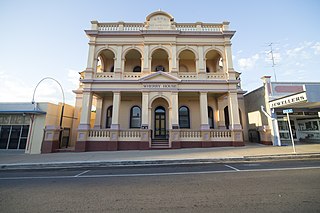
Bank of New South Wales is a heritage-listed former bank building at 34-36 Gill Street, Charters Towers, Charters Towers Region, Queensland, Australia. It was designed by Eyre & Munro and built in 1889 by Kelleher. It is also known as Wherry House. It was added to the Queensland Heritage Register on 9 November 2012.
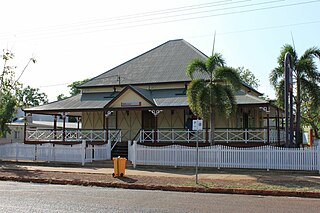
Westpac Bank Building is a heritage-listed bank building at Landsborough Street, Normanton, Shire of Carpentaria, Queensland, Australia. It was designed by Richard Gailey and built in 1886. It is also known as Bank of New South Wales. It was added to the Queensland Heritage Register on 21 October 1992.

